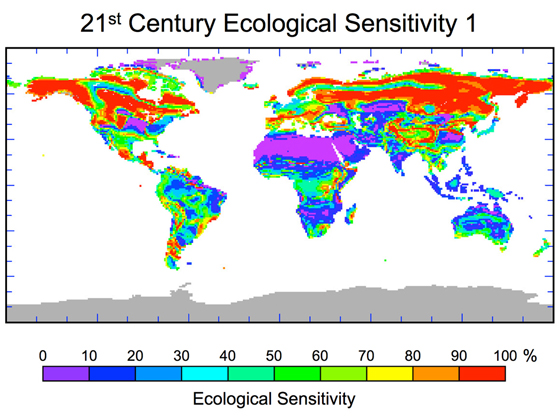Describe One Way That Ecosystems Respond to Environmental Change
Changes have been particularly rapid in the last 50. A community of organisms and the environment that the organisms inhabit.

Environmental Change Ecology And Evolutionary Biology Cornell Arts Sciences
Environmental change in the form of a sudden disturbance can damage and disrupt ecosystems.

. The detection of chlorophyll fluorescence is one way of examining plants responses to environmental changes. What role do nonliving things play in an ecosystem. Climate Change Indicators.
1 point for each description of an appropriate human activity. The system approach to studying Earth provides a way to understand the interrelated nature of the physical chemical and biological forces that shape the planet. Hairstons lab studies how individual species food webs and whole ecosystems are altered when the environment changes.
Changes in climate can affect the types of plants that can grow in an area. 12 How have environmental cycles changed. If the adaptation takes place over several generations the trait is an evolutionary adaptation.
I Describe the pattern shown in the graph. 1 point for a correct description of. Plants Animals and Ecosystems.
Earth as a System. Ewoldsen states that nitrates pose different threats to aquatic ecosystems than microbeads do. Researchers are continually looking for innovative ways of measuring these effects on global ecosystems.
Up to 24 cash back a Give one way in which an increase in household waste affects our environment. Why an energy pyramid is a representation of trophic levels. Plants Animals and Ecosystems.
One way that some freshwater organisms respond to environmental change is to evolve rapidly. Students have to describe not merely identify the human activity. Plants and animals have adapted to changes in the environment for millions of years.
Why Do I Need To Know This. They determine which plants and animals can live there. Describe the compositional and structural layers of earths interior.
A marked change in the environment favors some characteristics of plants animals and microbes over others. How energy transfer in a food web is more complex than energy transfer in a food chain. Changes have been more rapid in the second half of the 20th.
How nitrate levels can negatively affect water quality in some aquatic ecosystems. Can affect the ability of an area to sustain a human. However todays changes are happening faster and on a larger scale than in the past which makes it difficult for plants and animals to adapt.
Summarize how energy is transferred through an ecosystem. Ecosystems provide humans with food clean water and a variety of other services that can be affected by climate change. Describe one way that ecosystems respond to environmental change.
The prevent competition among populations. As global temperatures rise the most threatened ecosystems are those that depend on a season of snow and ice scientists from the nations Long Term Ecological Research LTER Network say. In general ecosystems react to changes in ways that maintain or restore balance to the ecosystem.
Organisms that make an adjustment to environmental conditions in their own lifetime make physiological adaptation. The capacity of ecosystems to provide benefits to humans that is to provide ecosystem services derives from environmental cycles of water nitrogen carbon and phosphorus. The graph shows how the mass of sulfur dioxide released in the UK has changed from 2001 to 2011.
Organisms often respond to their environment through adaptation. Climate change is increasing global temperatures and the regularity and severity of droughts. A Describe how TWO human activities other than those that result in anthropogenic climate change have resulted in a decrease in the amount of freshwater flowing into the Everglades ecosystem.
They provide shelter gases and liquids to plants and animals. A community of organisms and their abiotic environment. _____ _____ 1 b The release of sulfur dioxide affects our environment.
However over time organisms will migrate back into damaged areas in predictable patterns. Any change in the climate of an area can affect the plants and animals living there as well as the makeup of the entire ecosystem. Two types of consumers.
How does the Ecosystem Respond to Environmental Changes. The living and non-living components of the ecosystem can be altered by either natural factors or human management. Is the study of the complex relationships between living things and their nonliving or abiotic environment.
Most plants and animals live in areas with very specific climate conditions such as temperature and rainfall patterns that enable them to thrive. How energy is transferred through an ecosystem. Changes to ecosystems Ecosystems are very sensitive to change.
The changes caused by human activities have consequences for the biotic and abiotic parts of ecosystems. One way that ecosystems respond to environmental change. How energy is transferred from the sun to producers and then to consumers.
These processes have in some cases been significantly modified by human activity. The vulnerability of cool wet areas to climate change is striking. One way in which consumers depend on producers.
How do ecosystems respond to environmental change. This chapter looks at some of the ways that climate change affects ecosystems including changes in wildfires streams and lakes bird migration patterns fish and shellfish populations. Providingre-establishment habitats Describe one way that restoring the Everglades is expected to provide economic benefits to.
Describe one way that restoring water quantity and water quality in the Everglades is expected to improve the structure and function of the ecosystem.

Impacts To Species And Habitats Conservation In A Changing Climate

What Changes In Natural Ecosystems Are Caused By The Ongoing Global Warming Process

Climate Change May Bring Big Ecosystem Changes Climate Change Vital Signs Of The Planet
No comments for "Describe One Way That Ecosystems Respond to Environmental Change"
Post a Comment